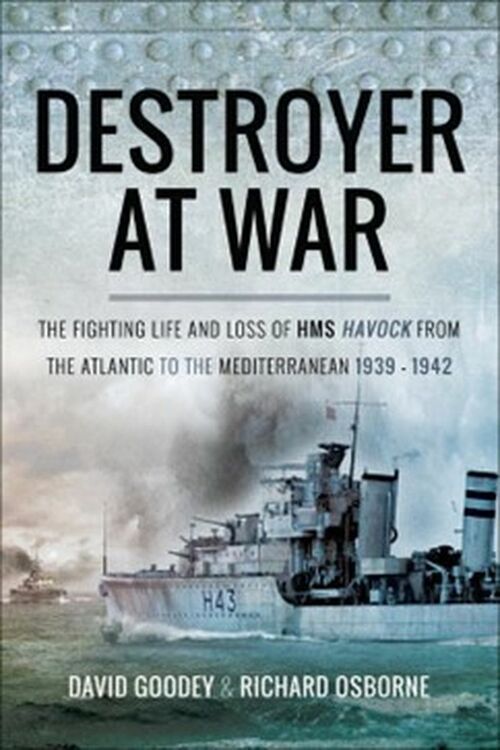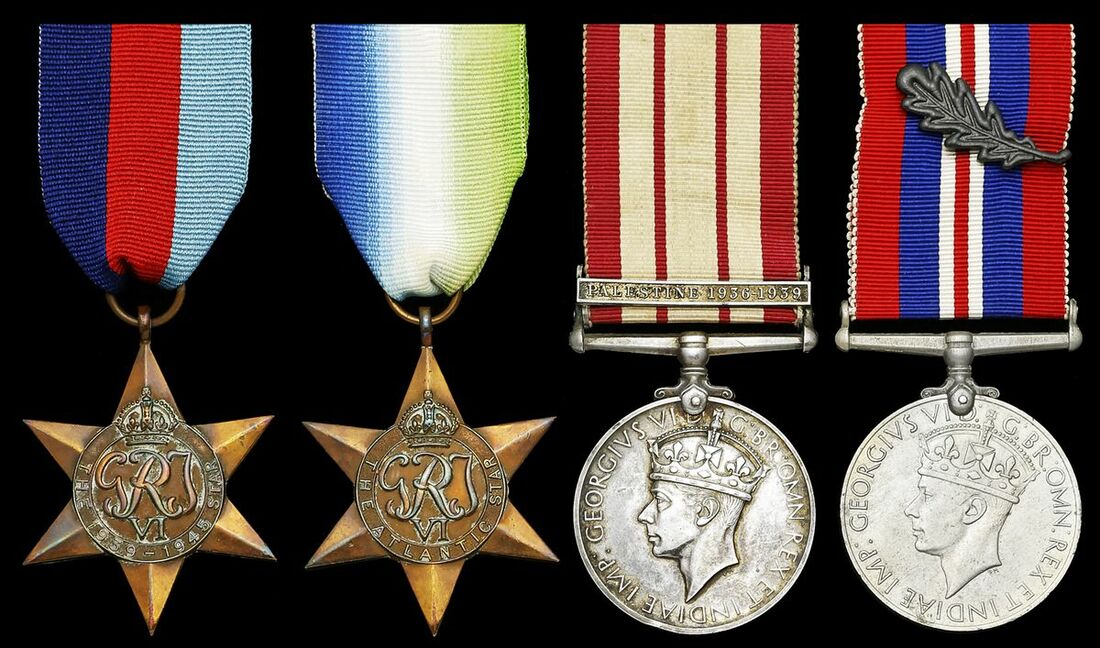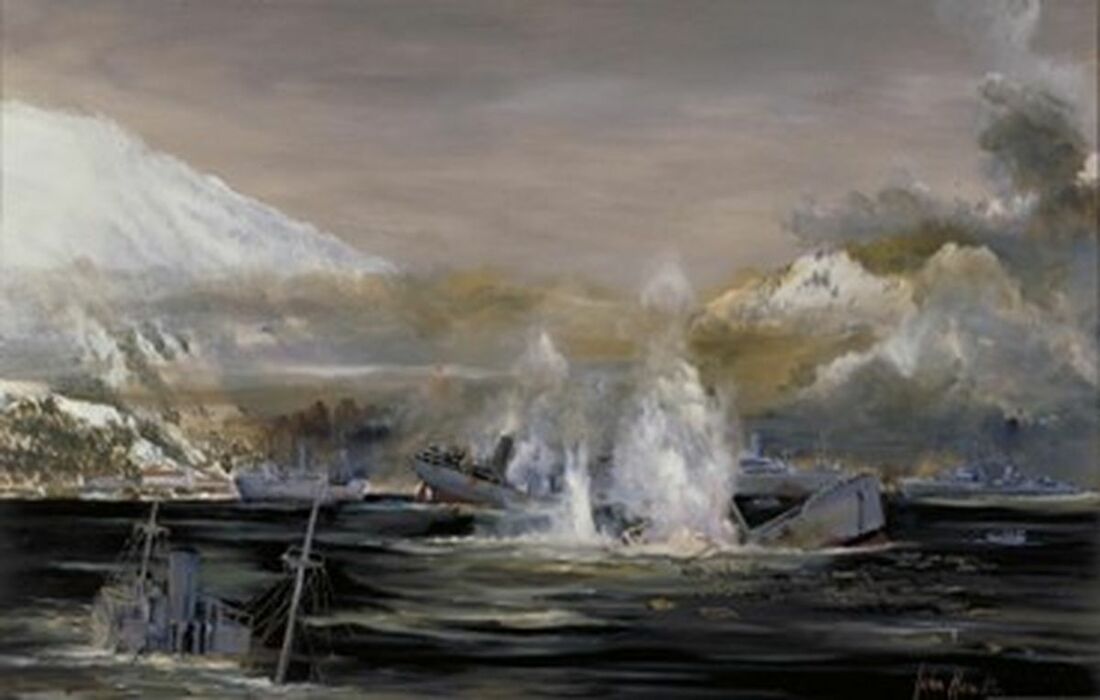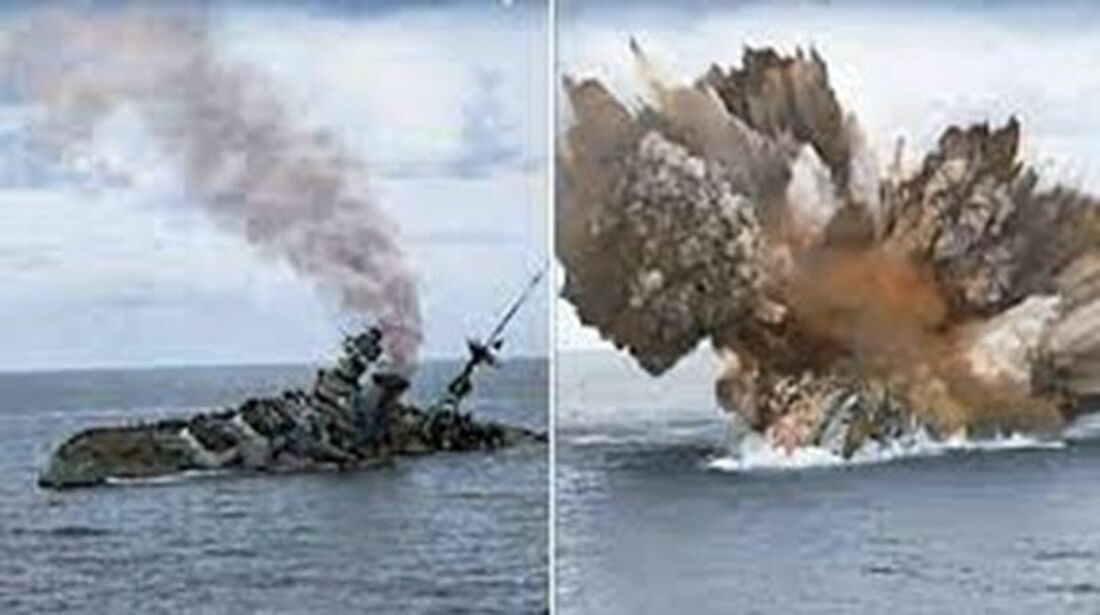Auction: 23002 - Orders, Decorations and Medals
Lot: 55
'The war is going to start properly soon, and I'm going to start it.'
So wrote Captain Bernard Warburton-Lee, Captain (D), 2nd British Destroyer Flotilla, in a letter his wife on 5 April 1940; when she received it the war had indeed properly started, and her husband had earned its first Victoria Cross - posthumously.
An exceptional and poignant pre-war Palestine operations and Second World War campaign group of four awarded to Able Seaman J. H. Starkey, Royal Navy
As a gun-layer in H.M.S. Havock in the 2nd Destroyer Flotilla, his skills were much in demand at the First Battle of Narvik in April 1940, when, in a series of point-blank encounters, her guns contributed to destruction or severe mauling of some ten enemy ships, over whom 'hung a sepulchral, acrid mist'
Starkey's skills were equally evident at the battle of Cape Matapan in March 1941, when he stepped in as Havock's Acting Director Layer and was mentioned in despatches for the 'marked success' of his actions, among them the destruction of an Italian destroyer
Tragically, his next appointment was to prove his last, for he was killed in the battleship Barham on 25 November 1941, when she famously blew up after being torpedoed between Crete and Cyrenaica
Naval General Service 1915-62, 1 clasp, Palestine 1936-39 (J. 102532 J. H. Starkey, A.B., R.N.); 1939-45 Star; Atlantic Star; War Medal 1939-45, with M.I.D. oak leaf, edge bruise to the first, otherwise good very fine or better (4)
John Henry Starkey was born in Lewisham, south London, on 6 May 1905 and entered the Royal Navy as a Boy 2nd Class in May 1921. Qualifying as a gun-layer in May 1936, he removed to the destroyer Havock in January 1937 and remained likewise employed until late May 1941. His C.O. was Commander R. E. 'Rafe' Courage, R.N., who would win the D.S.O. and Bar, and D.S.C. and Bar, in the same period, evidence - if it were needed - of a remarkable wartime commission. Earlier, in the lead-up to hostilities, Havock saw extensive service in the 2nd Destroyer Flotilla in the Mediterranean, including off Palestine and in Spanish waters at the time of the Civil War.
First Battle of Narvik - "Continue to engage the enemy"
So, now, to Havock's opening shots of the war, namely the 2nd Destroyer Flotilla's spectacular foray into Narvik harbour in the early hours of 10 April 1940. It was Warburton-Lee in the Hardy who led-in the opening attack but, just fifteen minutes later, Commander Courage in the Havock loosed off three torpedoes: 'The first hit a merchant ship; another, following the first's track, was displaced by the explosion so that it neatly dodged the stricken ship and hit another beyond her; and the third, though they were not necessarily in that order, took the Anton Schmitt in her second turbine room … ' (Narvik, Battles in the Fjords, Captain Peter Dickens, R.N., refers).
The latter broke in two and sank in a minute. Three torpedoes. Three hits. Dicken continues: 'The Havock's last trial in this first phase [of the battle] was a hail of rifle fire and machine-gun fire from the German troops at Framnes, which she returned in good measure with her foremost pair of 4.7s and got clear away. As the Royal Navy reports during exercises: 'Run one completed. The tranquil harbour at dawn twilight which Hardy had entered less than 30 minutes earlier was now transformed into a scene of horrible destruction … '
Hotspur and Hostile now entered the fray, the former delivering a telling torpedo strike and adding to the overall scene of carnage, good work that was followed up by some excellent gunnery:
'On both sides gunnery was blind but intense, and the mountains echoed the thunder of discharge to join with the next salvo and amplify it to the level of the crack of doom. There was no formation, and each British ship positioned herself so as best to engage the stabbing, lurid gun-flashes when they appeared' (ibid). Aboard Havock, Starkey and his comrades did just that, scoring a brace of 4.7-inch hits on the Z18 Hans Ludemann. As concluded by Dickens, Narvik was now a 'graveyard of ships, an untidy one with the tombstones at all angles. There were ships with their bows in the air; ships with only lolling masts and funnels in the air; ships with little to show that they had ever been…over them all hung a sepulchral, acrid mist.' As it transpired, however, a new enemy awaited Havock and her consorts as they made their way back into Ofotfjord, namely five destroyers of the German 4th Flotilla. A protracted and bitter contest ensued, in which the Hunter and Warburton-Lee's Hardy met their end. The Hotspur was seriously damaged, too, and Havock had more than her fair share of near misses and shell-splinters.
Yet, amidst the mounting carnage, Havock finished-off another victim, the Rauenfels. A large merchantman, she was laden with ammunition for the enemy garrison at Narvik, and the resultant explosion was spectacular. One eyewitness swore he saw the enemy ship's funnel gyrating in the sky. Hostile signalled Havock, "Are you all right?":
"Only just," came back the reply.
The events of that memorable day are perhaps best summarised in the citation for Warburton-Lee's posthumous V.C.:
'For gallantry, enterprise and daring in command of the force engaged in the First Battle of Narvik, on 10th April, 1940. On being ordered to carry out an attack on Narvik, Captain Warburton-Lee learned that the enemy was holding the place in much greater force than had been thought. He signalled to the Admiralty that six German destroyers and one submarine were there, that the channel might be mined, and that he intended to attack at dawn. The Admiralty replied that he alone could judge whether to attack, and that whatever decision he made would have full support. Captain Warburton led his flotilla of five destroyers up the fjord in heavy snow-storms, arriving off Narvik just after daybreak. He took the enemy completely by surprise and made three successful attacks on warships and merchantmen in the harbour. As the flotilla withdrew, five enemy destroyers of superior gunpower were encountered and engaged. The captain was mortally wounded by a shell which hit the bridge of H.M.S. Hardy. His last signal was "Continue to engage the enemy".'
The Mediterranean beckons
During the battle of Cape Spada on 19 July 1940, Havock escorted the Australian light cruiser H.M.A.S. Sydney and rescued some of the 525 survivors from the Italian cruiser Bartolomeo Colleoni, together with the other escorting destroyers. Her boiler room was flooded following an attack by Italian aircraft after the battle and she was repaired at Suez from 29 July to 15 September. Back in action, Havock and her sister Hasty surprised the Italian submarine Berillo on the surface on 2 October off the coast of Egypt and forced her to scuttle herself. The destroyers rescued 47 survivors between them.
Cape Matapan
During the Battle of Cape Matapan, Havock torpedoed and sank the Italian destroyer Alfieri on 28 March 1941. Starkey was mentioned in despatches (London Gazette 3 February 1942, refers), the recommendation stating: 'For conspicuous zeal and energy as Acting Director Layer during the night action on the 28th March. The Director Layer having gone sick shortly before sailing, Able Seaman Starkey filled his place with marked success and assisted the Temporary Trainer, as well as doing his own work.'
Greece and Crete
In common with her consorts, Havock was next ordered to assist in the evacuation of Greece and she was one of three destroyers to escort the cruiser Ajax at a bombardment of Benghazi on the night of 7-8 May 1941. However, later in the month, while patrolling off Heraklion, Crete, Havock was attacked by enemy dive bombers and suffered a loss of 15 killed and then wounded. Starkey came ashore a few days later.
Journey's end
He next joined the battleship Barham in May 1941 and was likewise employed at the time of her loss. By way of summary, the following account of the incident, by Viscount Cunningham, is quoted:
'In the early hours of November 24th [1941] two enemy convoys were reported at sea making for Benghazi. Force 'B', consisting of the Ajax, Neptune, Naiad, Euryalus, Galatea and four destroyers, the whole under Rear-Admiral Rawlings in the Ajax, sailed at 4 a.m. to intercept. Force 'K', in the Central Mediterranean, returned to Malta, refuelled and went to sea again.
At 4 p.m. the same day I sailed from Alexandria with the Queen Elizabeth, Barham, Valiant and eight destroyers to be within call if enemy heavy ships put in an appearance. At about 4.30 p.m. next afternoon, November 25th, when the battle-fleet was patrolling between Crete and Cyrenaica, I was sitting in my bridge cabin in the Queen Elizabeth having tea.
I suddenly heard and half-felt the door give three distinct rattles and thought we had opened fire with our anti-aircraft guns. I went quickly up the one ladder to the bridge and then I saw the Barham, immediately astern of us, stopped and listing heavily over to port. The thuds I had heard were three torpedoes striking her. She had been torpedoed by a U-boat. The poor ship rolled nearly over on to her beam ends, and we saw the men massing on her upturned side. A minute or two later there came the dull rumble of a terrific explosion as one of her main magazines blew up.
The ship became completely hidden in a great cloud of yellowish black smoke, which went wreathing and eddying high into the sky. When it cleared away the Barham had disappeared. There was nothing but a bubbling, oily-looking patch on the calm surface of the sea, dotted with wreckage and the heads of swimmers. It was ghastly to look at, a horrible and awe-inspiring spectacle when one realized what it meant. The destroyers were quickly on the scene, some to hunt the submarine, others to pick up the survivors.
But though the U-boat had broken surface after firing, and passed so close down the side of the Valiant that the guns could not be sufficiently depressed to hit, contact was never made. About four hundred and fifty survivors were rescued, including Vice-Admiral Pridham-Wippell, but Captain G. C. Cooke, fifty-five other officers and eight hundred and six men lost their lives. It was a most distressing calamity. I saw many of the rescued later in hospital. Some of them had sustained horrible injuries through sliding down the ship's bottom as she rolled over. The Barham had been out of dock for six months, and the barnacles had grown to an enormous size in the warm water of Alexandria. The First Sea Lord sent us a message of condolence, and when next I wrote to him I said: "We very much appreciated your signal about the Barham. She is indeed a heavy loss. We blundered straight onto the submarine. There was no necessity for us to be there any more than anywhere else.
It was a most daring and brilliant performance on behalf of the U-boat, which fired from a position about two hundred yards ahead of the Valiant. If there is anything to be learnt from it, it is that our anti-submarine vessels are sadly out of practice. I am withdrawing the Otus (submarine) from operational duty to run her as a 'clockwork mouse'." 'In other words, for the instruction of anti-submarine ratings.' (Cunningham's A Sailor's Odyssey, refers).
For further details, including survivors' accounts, see: http://www.hmsbarham.com/index.php
Postscript
Starkey had been awarded the L.S. & G.C. Medal in May 1938, which award was likely lost in the Barham, but his Naval General Service Medal for Palestine was issued to his next of kin - his widow, Annie Margaret Starkey - in April 1942. Having no known grave, he is commemorated on the Chatham Naval Memorial.
Subject to 20% VAT on Buyer’s Premium. For more information please view Terms and Conditions for Buyers.
Sold for
£450
Starting price
£200











